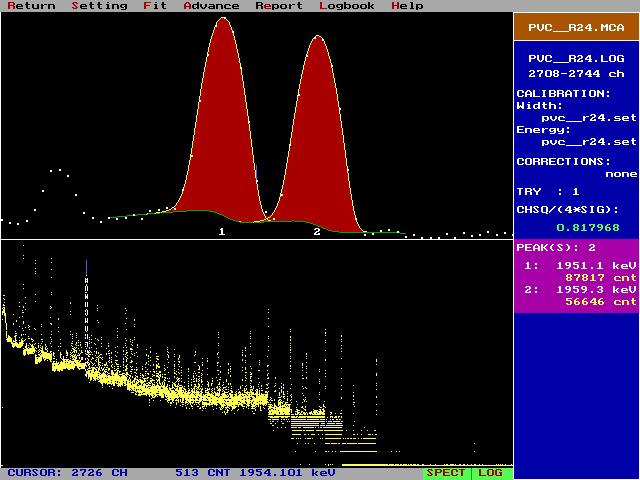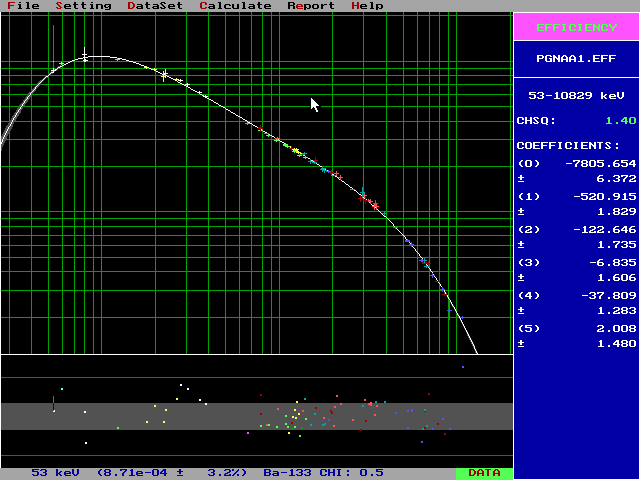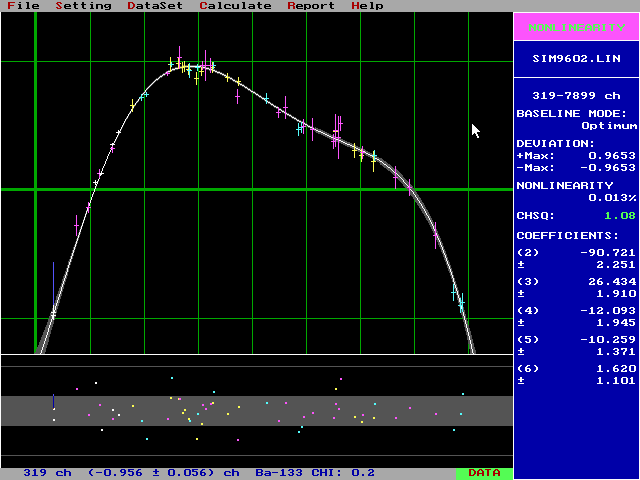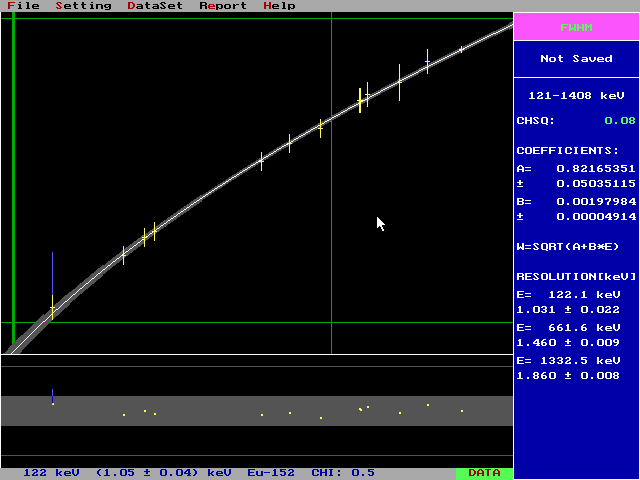Hypermet-PC
IMPORTANT ANNOUNCEMENT
From 1 January, 2008, the licencing conditions of Hypermet-PC have been changed, so now it is available FREE OF CHARGE. You can download the full-featured version from this website.Feature list
Compatibility tips
Downloads
Customer care
Introduction
The original HYPERMET code was
developed in FORTRAN language by Phillips
and Marlow in
the early seventies, at the Naval Research Laboratory, Washington D.C.
for automatic and efficient analysis of multichannel pulse-height
spectra using a high-speed mainframe computer. The authors' governing
principle has been to require minimal input from the user in order to
save manpower and to minimise human errors.
To achieve reliable results by automatic fitting, a carefully chosen semi-empirical parameterized function was adopted to represent the detector response of Ge(Li) and HPGe detectors, including all physical and statistical effects which contribute to a real spectrum. The peak shape function of HYPERMET is the linear sum of a Gaussian and an exponentially-modified Gaussian (EMG) on the left side. On the other hand, a step function folded with the same Gaussian and a similarly folded "tail" function, resembling a sharp Compton edge, are added to the usual first or second order polynomial background function.
The fit becomes nonlinear as far as parameters of the Gaussians and exponentials are allowed to vary. Fully automatic operation means that the parameters of peaks and background are found by a nonlinear fit for each separate region in the spectrum, starting from an initial guess.
Therefore, even very complicated multiplets can be successfully and automatically resolved with minimal user interaction. Note that multiplets may have curved, stepped or backstepped background, and peaks with different FWHM. The approximate widths and energy values of two distant peaks provided by the user are the only input needed.
At the time when HYPERMET was introduced only high-speed mainframe computers could be used efficiently due to the time-consuming nonlinear fitting involved. With some modifications the program became fast enough for use on personal computers. The progress of object-oriented programming languages in the '90s has motivated the development of an interactive version with a user-friendly graphics interface. In parallel, high-quality calibration routines and other innovative features were also introduced.
Thanks to these characteristics, Hypermet-PC has gained general acceptance and is applied with success in numerous PGAA, NAA, and other gamma-spectroscopy laboratories. Its remarkable peak evaluation performance was proven in the international intercomparisons.
Feature list
- Supports most common multichannel spectrum formats:
- System 100 ( *.mca files, used by CANBERRA S-100 MCAs)
- AccuSpec ( *.dat files, used by CANBERRA / NUCLEAR DATA AccuSpec MCA's)
- ORTEC ( *.chn files, used by ORTEC MCA cards)
- SAMPO-90 ( *.spe files, generated by SAMPO-90 program)
- Nucleus ( *.spm files, generated by NUCLEUS MCAs)
- Silena ( *.dat, Silena spectrum file format)
- SEIKO ( *.chn files, used by SEIKO MCAs)
- ASCII ( *.asc, plain text files used by many companies, e.g. KFKI EPCA cards etc.)
- DCHYP (*.hpc, a special format to store up to 4 spectra in a compressed form.)
- Canberra's CAM Files (*.cnf, created by the data acquisition software Genie 2000) can also be loaded after converting to S100 *.mca format. A free converter utility is offered for this purpose.
- Automatic spectrum fitting
This
picture shows a successfully fit on a region of
a PGAA spectrum. Please
note the multiplet fit, as well as the step-shape background. The fit produced automatically
without manual interaction.

- Gamma spectroscopy data for calibrations
A collection
of high-quality energy and intensity data, half-lives and the
respective uncertainites for many radioactive sources and (n,gamma)
reactions, used for detector calibration and spectrum evaluation. One
can extend the dataset by adding the certified activities of
radioactive sources, to produce the absolute efficiency curve.
- Determination of absolute and relative full-energy peak efficiency
The
image illustrates the efficiency curve constructed from separate
measurements.They were performed using absolute intensity calibrated or
non-calibrated radioactive sources, as well as using the PGAA method.
The use of orthogonal polynomials ensures the numerical stability of the
fits. The confidence band of the interpolation curve is also calculated.

- System nonlinearity for precise energy measurement
To
determine high-precision peak positions in energy units, one has to
correct for the small bias in linearity present at most spectrometry
systems. This is called nonlinearity correction. This is
especially important when using Efficiency and Nuclide Identification
modules, because the algorithms try to locate peaks in the
vicinity of their literature energy values (typically ± 0.5
keV). In practice, by using just the two-point energy calibration and
neglecting nonlinearity correction, a rather large deviation in peak
positions can be expected (1-3 channels), and incorrect uncertainty
data will appear in the peaklist report files (in general,
uncertainties will be smaller than the real values if user do not apply
nonlinearity correction).
Nonlinearity
correction results in significant improvement in accuracy on peak
centroid determination and takes only a few minutes to
create. The
figure shows the automatically constructed system nonlinearity curve
for a given detector system.

- FWHM (detector resolution) vs. energy curve fitting

- ADC test module
The
differential nonlinearity specifies the non-uniformity of the ADC’s
channel widths. For the measurement, a sliding pulser signal (e.g. BNC
PB-1 Pulser with LG-1 Ramp Generator) should be connected to the ADC
input. In order to reduce the statistical error, the measurement
typically takes 10-24 hours to collect sufficient data (usually 100 000
counts in each channel). The differential nonlinearity - expressed in
percentage - is the maximum deviation of counts in any channel compared
to the average number of counts in all channels.
- Support for Dual Loss Free Counting (LFC) spectra
The
Loss-Free Counting (LFC) method provides the ability of performing
real-time correction of system counting losses needed e.g. when
measuring short-lived radionuclides in NAA. Among the several
implementations the Westphal’s Virtual Pulse Generator technique of LFC
seems to be the most advanced, which proved to be accurate up to 700
kHz. Since the LFC adds n rather than one for every event that is
stored, the counting statistics of the corrected spectra is non-Poisson
in nature. Consequently, the use of conventional peak search routines
for LFC corrected spectra would result in hundreds of false peaks. A
straightforward solution, marketed by Canberra, is the Dual Spectrum
LFC module which accumulates a loss-free corrected and an uncorrected
spectrum simultaneously in adjacent halves of the memory. Analysis of
such a tandem spectrum provides more accurate quantification of the
data than analysis from a single spectrum.
- Nuclide identification for NAA and PGAA
This
option is intended for qualitative and quantitative analysis of
gamma-ray spectra, applicable for almost every popular measurement
method (e.g. different types of neutron activation analysis, prompt
gamma activation analysis, fission product monitoring, charged-particle
activation, photoactivation etc.). At this stage only a
simple analysis of NAA and PGAA spectra is implemented.
- Various output formats (CSV, PKL, Sampo) for further data processing
- Comma separated value file (*.csv). Convenient to load data to spreadsheet applications
- Peak list file (*.pkl). Contains peak positions, energies, intensities, all uncertainites and the chi-value
- Sampo-90 compatible output (*.ptf). This is widely used in a number of composition-calculation programs, such as KAYZERO/SOLCOI, a software package for k0-NAA.
Customer care
- For technical assistance, please contact Dr. László Szentmiklósi

